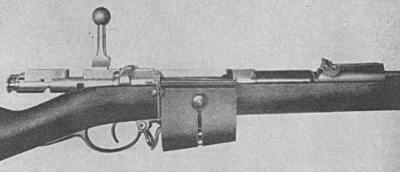The following information on the Mauser’s French competitors comes from Chapter 8 of Mauser Rifles and Pistols by W. H. B. Smith. Mauser Rifles and Pistols is also available to purchase in print.
When the French finally awoke to the fact that the Germans had completely equipped their army with repeating rifles, France undertook the development of a similar magazine rifle. In his “Military Small Arms and Ammunition” (1902), R. H. Angier, one of the outstanding English authorities in the last quarter of the Nineteenth Century writes: “Desultory experiments were made with magazine arms, but no Great Power followed the example of Switzerland until it became known that the German Government had quietly re-armed the troops stationed along its Western frontier with Repeating Rifles. The inevitable counterstroke soon followed in the next year, rumors, gradually crystallizing into positive statements, appeared in the public press, of a new Magazine Rifle adopted by the French Government, and being issued with all speed to the French troops. Everyone will remember the accounts, largely fanciful, given of its wonderful powers, and the precautions, as elaborate as futile, taken by the French Government to preserve the secret of their new ammunition. In 1885 one M. Vielle, a French chemist working at the French Government powder factory developed the first successful smokeless powder. This powder developed a higher velocity with comparatively lower pressure than the earlier black powder, and left very little residue in the barrel, which, together with its smokeless quality, led the French to develop a rifle of comparatively small bore, 8 mm (.315 inch) which was more efficient than the earlier heavy bore rifle being used by the German. Indeed this French Lebel, as it was called after Gen. Lebel of French Ordnance, the developer, was the first truly modern small bore rifle.”

The German Army Commission experimented to produce a small bore rifle to use smokeless powder to counter this new development of the French. From this developed the next German-adopted weapon manufactured but not invented by the Mauser organization, one which has been the subject of great controversies.
At this juncture it might be well to state that early Mauser rifles, quite like the later ones, were manufactured at many plants besides those of Mauser at Oberndorf. Specimens may be found bearing the marks of the government arsenals such as Amberg, Danzig, Erfurt or Spandau. They will also be found marked “Oesterr. Waff Ges.,” many having been made by the Steyr works in Austria. At a very early date liaison between the German Mauser factories and those of Austria and Belgium were already underway. Effective liaison was later to spread to Belgium, Czechoslovakia and Spain; countries which have always filled foreign orders for Mausers when the German factories were either too busy or were closed after wars.
Before passing on to the next German Army Rifle, Model 1888 mention must be made of the Serbian cal. 10.15 and the Turkish 9.5 mm weapons designed and made by Mauser.
